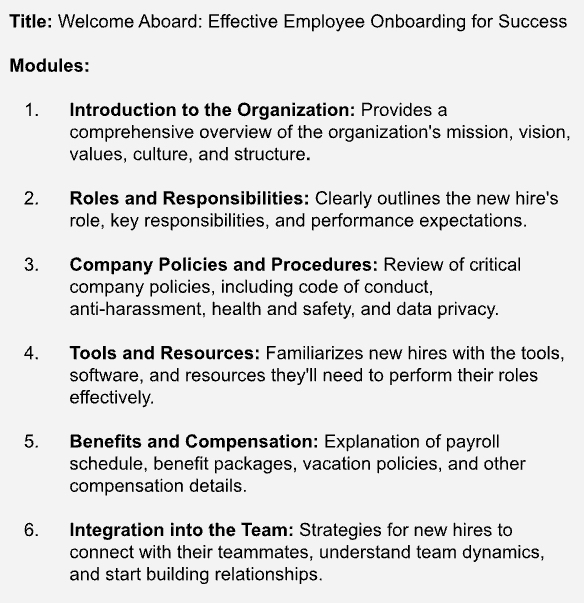Off-the-Shelf eLearning: Why You Should Use Off-the-Shelf eLearning Content for Your Business
Michael Keenan | WorkRamp Contributor
View bioLearning Tips Straight to Your Inbox
Keeping employees up to date with necessary skills is more critical than ever.
Learning new skills to remain competitive is critical for employees to future-proof themselves against disruptions like automation, which some 40 percent of workers fear will make their jobs obsolete in the next five years.
However, developing an entire L&D program in-house is time-consuming and expensive. You have to account for instructional design, content development, and testing.
Off-the-shelf content makes life easier. It comes ready-made, created by subject matter experts. Plus, it saves you time and money and gives employees access to standardized learning resources.
Discover how off-the-shelf content can transform your workforce into a powerhouse, fueling the innovation and success that propels businesses forward.
In this post:
What is off-the-shelf eLearning?
“Off-the-shelf” eLearning refers to pre-designed learning content. You can use it “out of the box,” meaning you can use it in your training content immediately. Off-the-shelf content covers various topics, like leadership skills, health and safety, project management, customer service, and more.
Let’s look at an example. Say you are the manager of an IT company and want to train employees on Cyber Security fundamentals. Instead of hiring an instructional designer and developer to create the course from scratch, you can buy off-the-shelf content.
Vendors like OpenSesame or Go1 may already have eLearning content on the topic. A learning management system like WorkRamp also offers prebuilt content for professional development, compliance training, and more.
Simply purchase a license for your team, assign the courses in an LMS, and your training is ready to go.
Off-the-shelf learning vs. custom learning
The terms “off-the-shelf” and “custom” learning refer to two different approaches to creating educational content.

Off-the-shelf learning
Off-the-shelf learning materials cover common topics. They are not specific to any one company or industry.
This type of content applies to a broad audience across different industries.
Pros:
- Cost-effective: Since these courses are mass-produced, they are generally less expensive than custom-made courses
- Quick to implement: Courses are already complete, so you can implement them into your L&D program quickly
- Professional content: Content is created by subject matter experts, so it’s accurate and high quality
Cons:
- Lack of customization: Your brand, culture, or needs might not perfectly match these courses
- Generic approach: Depending on your industry or company, the courses might lack depth in certain areas
Custom learning
The other side of the coin is custom learning, which involves creating content specifically for your organization. Your L&D team develops the courses in-house or works with external vendors based on your specific requirements.
Say you’re running a customer education program and want to train partners on proprietary software; you’d create custom learning content.
Pros:
- Tailored content: You can design learning materials that align perfectly with your organization’s goals
- Relevance: It’s a good way to improve employee engagement because the content is specific to their needs
Cons:
- Higher costs: Developing custom content is time-consuming and expensive, especially if you’re hiring external partners
- Longer implementation time: Custom courses take time to develop, which can delay starting your training program
Choosing between off-the-shelf and custom learning depends on your organization’s specific needs, budget, and timeline.
A blended approach, using off-the-shelf content for more generic topics and custom content for more company-specific subjects, is key to a balanced and efficient strategy.
Off-the-shelf eLearning content topics
Whenever you start a new training program, you have a lot of topics to cover. The best part? Many content providers already have courses built around these topics and are ready to share.
Here are some common topics you’ll find from off-the-shelf providers, with examples and how to use them.
Diversity, inclusion, and unconscious bias
This topic covers the importance of a diverse and inclusive workplace. It’s become popular in recent years, with some 67 percent of US organizations reporting some use of diversity training.
Diversity, inclusion, and unconscious bias training includes all types of diversity:
- Race
- Ethnicity
- Gender
- Age
- Socio-economic status
It makes a good off-the-shelf topic because:
- It’s universally relevant regardless of industry size, industry or location
- Many jurisdictions require workplace diversity and inclusion training. Off-the-shelf courses can help companies meet these requirements
- Deloitte found that diversity training can enhance team innovation by up to 20%
You might use this content as part of their broader initiative to create an inclusive work environment.
For example, you could require all team members to complete the course as a baseline for joining the team. It may also spark conversations about how diversity and inclusion are handled internally and can inform future organizational policies and practices.
👉Example course
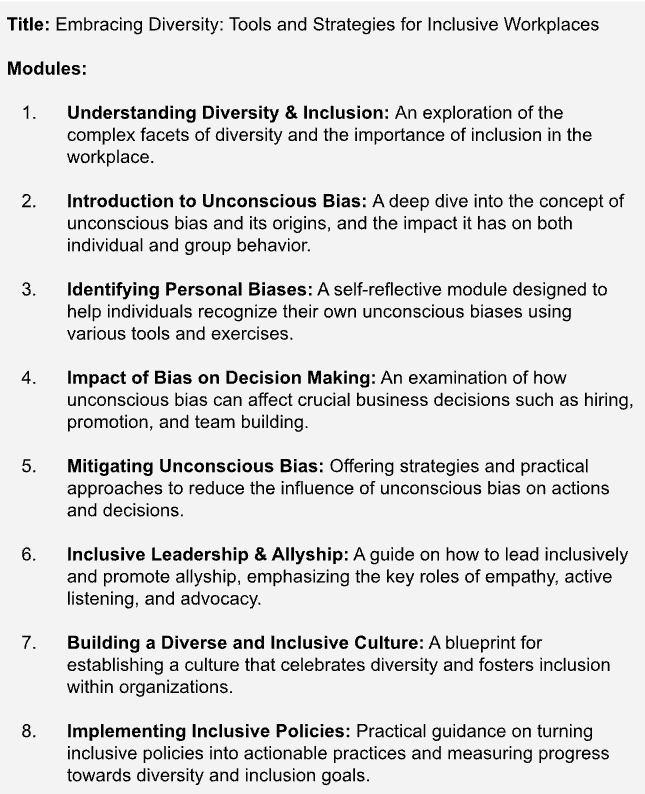
Soft skills
Soft skills are abilities that contribute to successful interactions and relationships. They’re also called people skills or interpersonal skills. In contrast to technical skills, which are often specific to a job or industry, soft skills are transferable and valuable anywhere.
Soft skills training will include material on:
- Communication
- Teamwork
- Adaptability
- Problem-solving
- Critical observation
- Leadership
It’s a smart off-the-shelf topic because:
- The demand for soft skills is on the rise as automation continues to replace routine tasks
- Soft skills help with creativity, decision-making, negotiation, and managing people
As a manager, you can incorporate soft skills training into various areas:
- Staff onboarding: New hires can complete soft skills training modules during orientation. This gives them a solid foundation in communication, teamwork, and problem-solving
- Continuous development: You can provide ongoing access to soft skills training for all staff as a form of continuous learning. Regular refresher courses keep these skills sharp
- Addressing performance issues: If a team member is struggling with a particular aspect of their role, such as communication or teamwork, you can recommend specific soft skills training modules to help them improve
- Leadership training: Managers aspiring to higher positions can benefit from soft skills training. They can take courses on topics like strategic thinking and conflict resolution
👉Example course
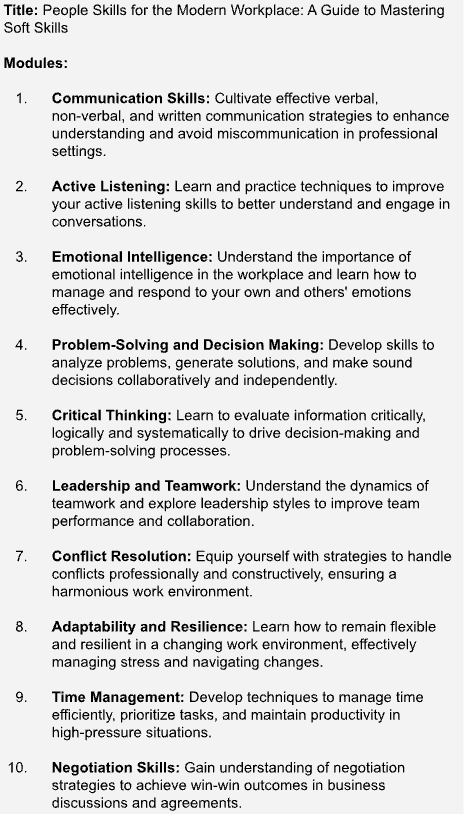
Compliance training
Compliance training teaches employees the laws, regulations, and company policies that apply to their day-to-day jobs. Regulatory bodies like OSHA determine these rules to keep workplaces safe and ethical.
You can find off-the-shelf compliance training on topics like:
- Workplace safety
- Anti-harassment
- Data protection and privacy
- Anti-bribery and corruption
There are industry-specific regulations to consider, too.
Compliance training isn’t an option; it’s a legal requirement in many areas. It’s a good type of off-the-shelf training because:
- It’s defined by laws and regulations and doesn’t need a lot of creativity or interpretation
- Providers handle these updates automatically, so you know training is always up to date
If there’s a violation of company policy or regulations, managers can use compliance training as a proactive step to prevent future occurrences. This may involve retraining the individual involved or retraining a department or the whole company if the violation highlights a broader misunderstanding.
👉Example course
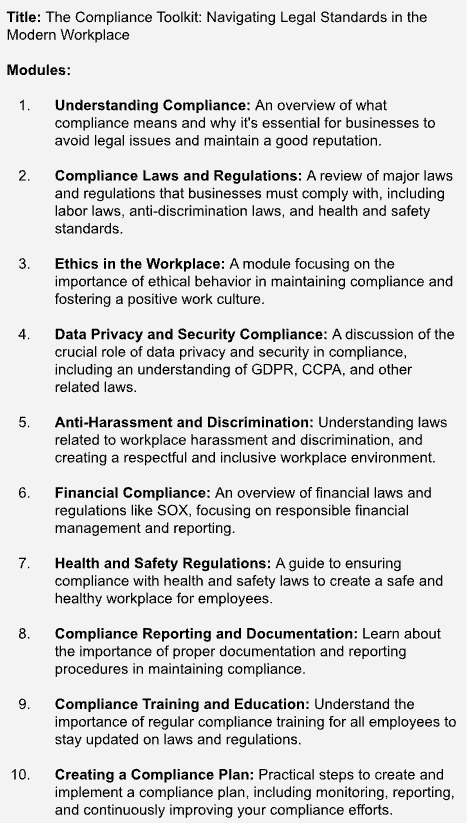
Professional development
In professional development, you learn and develop skills to advance in your career. Communication, leadership, critical thinking, and problem-solving are usually the focus. Courses can also cover job-related skills, industry trends, and emerging technologies.
Professional development is universally relevant, so it’s perfect for off-the-shelf content. Everyone can benefit from it, regardless of industry, job, or experience level.
👉Example course
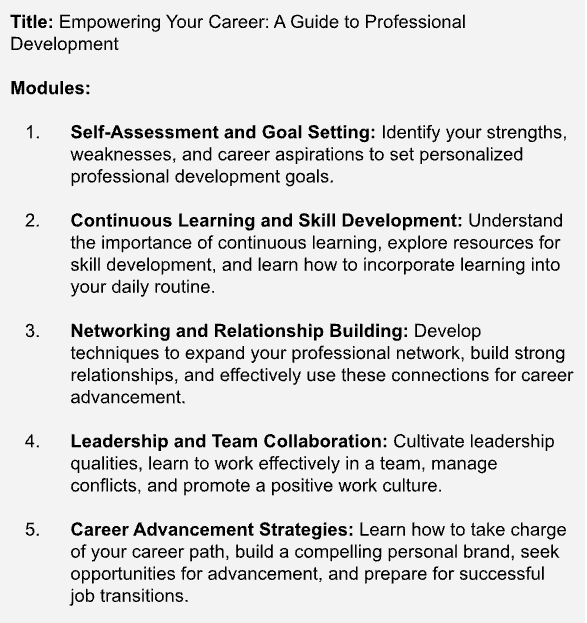
Employee onboarding
A new employee onboarding process integrates new hires into the organization. It involves getting them up to speed on job responsibilities, working norms, company culture, and objectives.
It makes a good off-the-shelf topic because:
- Every organization, regardless of its size or industry, needs to onboard new employees
- All companies have the same onboarding components. You can create a standardized curriculum that covers the core aspects and then customize it for your company
- Onboarding online can be more efficient and cost-effective than in-person onboarding. New hires can learn at their own pace, revisit materials as needed, and HR and management can reduce manual work
Managers can tailor the onboarding process to their specific department or job role by adding, modifying, or supplementing content. It could be policies, expectations, or procedures specific to the department.
With an LMS, you can add quizzes, games, and discussion forums into content to increase engagement and knowledge retention.
👉Example course
Sales
Almost every business requires some form of sales. Core sales skills are often consistent across industry, which makes the content easy to standardize.
Off-the-shelf sales content covers a wide range of topics:
- Fundamentals
- Strategies
- Negotiation
- Tools
- Relationship management
They also include scenario-based learning and real-world case studies to help learners better understand the sales process. Learners can immediately apply sales skills in real-world situations to reinforce learning.
You can also use it to identify your sales team’s skill gaps and upskill them. If your team has trouble negotiating, there’s probably a module in the sales content that can help.
👉Example course
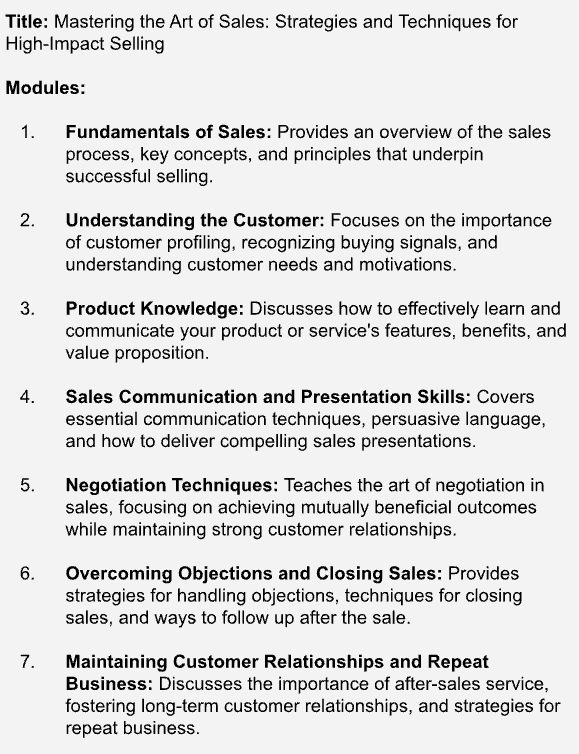
Customer training
A company educates its customers about its products or services through customer training. This could include information about how to use a product, troubleshooting methods, and benefits.
The specifics of customer training vary based on your company and its offerings. But, the principles of effective customer education are the same.
Imagine you work at a SaaS company. It’s your job to teach customers how to use your new software.
Using off-the-shelf eLearning content on customer training is a good starting point. You’ll learn how to break down complex tasks into manageable chunks, use multimedia for various learning styles, and incorporate interactive elements for better engagement.
Once you’re familiar with these principles, you can work with subject matter experts (SMEs) to customize the content for your products. Perhaps you could create videos showing how the software works, design quizzes to test knowledge of key features, or even create a simulated environment so customers can practice.
When the course is ready, you can put it on your customer support portal. You can let your customers access the training anytime, anywhere, and at their own pace, so they’ll learn more about your products, reduce support tickets, and ultimately be happier.
👉Example course
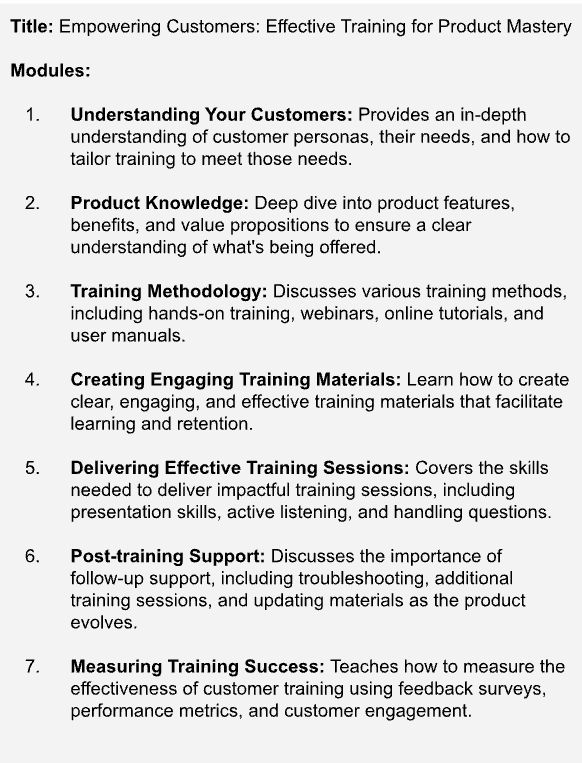
Benefits of using off-the-shelf eLearning content
Quick and accessible
Off-the-shelf eLearning is pre-built, readily available digital training. Combining this with a Learning Management System (LMS) ensures easy access, enabling learners to engage with content whenever and wherever they want.
Access to various topics
Off-the-shelf learning content is like a giant library of topics. Teams can develop training programs without making lessons themselves—everything from using office tools to studying data or knowing the rules for certain jobs.
Employees can also choose their own learning path with so many topics. They can learn what they need for their jobs and explore things they’re interested in or might be useful in the future. They can keep learning new things, which helps them do better in their jobs and be more valuable.
Consistent learning materials
Since professionals develop off-the-shelf content, it’s high-quality. It’s often peer-reviewed and tested before it’s released, so all learners have the best education possible.
Since the content is held to such high standards, you can implement it to provide uniform training across the entire organization. Everyone will have the same level of knowledge and understanding of a topic.
Paced by the learner
Studies show that learning is enhanced through self-guided study. But there are two necessary components: monitoring and relevant course content.
Off-the-shelf content is built with self-paced learning in mind. It lets learners revisit information, re-take tests, and track their progress throughout courses. Paired with an LMS, you can put learners on a customized learning path with off-the-shelf content that gives learners control over their education and improves performance.
Time savings
Off-the-shelf eLearning can save you a lot of time. You can use this ready-made learning material right away. You don’t have to spend hours creating a course from scratch.
The prebuilt courses make it easy to respond to training needs. You pick the relevant content, and you’re good to go. By being flexible, you can keep up with changing demands without losing time.
Variety of learning formats
You can find off-the-shelf eLearning content in a lot of different formats. Marketplaces offer videos, quizzes, interactive modules, text-based materials, and more. There’s a format for everyone, so you can find one that works for your team members.
It’s also fun to learn in a variety of formats. Learners are less likely to lose interest if they switch between video, text, and interactive content. Off-the-shelf content not only educates but also maintains learner engagement, an essential component of effective instruction.
Works within your LMS
Off-the-shelf content also plays nice with your LMS. You can easily upload and manage the content on a platform like WorkRamp. This saves you time and makes it easier to track business outcomes.
Some systems, like WorkRamp, provide a marketplace to buy learning content.
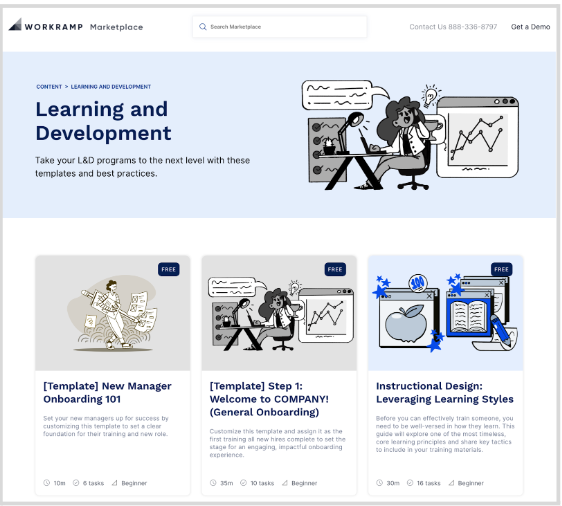
As a bonus, off-the-shelf content lets you focus on learning goals instead of technical details. It’s like getting a book to put on your library shelf. You don’t have to worry about binding, just about who might be interested.
As a result, you can spend more time implementing and customizing your learning program, leading to better results.
Limitations of off-the-shelf eLearning
Customization opportunities
An off-the-shelf eLearning course is like a ready-to-wear outfit. Because it was designed for a broad audience, not specifically for you, it might not have the perfect fit or favorite color.
That’s one limitation with off-the-shelf content: It lacks customization options. They are made to meet general learning needs and may not fit your team’s learning goals or style.
The upside is that you can tailor the content once it’s in your LMS.
You can:
- Incorporate company-specific information. Add case studies, specific examples, or scenarios to make the content more relevant for learners.
- Change the assessment methods. Add or change quizzes and assignments to better fit your learning goals.
- Blend with instructor-led training. Use off-the-shelf content for foundational knowledge. Then bring in a live instructor for more specific, company-related discussions.
- Localize content. Tweak content to suit local languages, laws, customs, regulations, and examples.
eLearning content providers
Building out a learning program will be tough if you work with a bad content provider. They might give you content that is hard to understand, irrelevant, or just plain boring. They might also not update content, which makes it less useful over time.
When planning to purchase content from a provider, here are some questions to ask:
- How well does the content align with our specific training needs and goals?
- What options are there for customizing the content? Can we add our own branding, change the sequence of modules, integrate our own examples, or make other modifications?
- How often is the content updated to reflect changes in laws, regulations, industry best practices, or the latest research? Is there a cost for updates?
- How is the content designed to engage learners? Does it use interactive elements, multimedia, quizzes, or other methods to keep learners interested and facilitate retention?
- Is the content compatible with our existing Learning Management System (LMS)? Is it SCORM or xAPI compliant?
- How is the content licensed? Is it a one-time purchase, or does it require a subscription? Can the content be used across multiple locations and for a large number of employees?
- What kind of support do you provide? Is there technical support available if we have issues with the content?
- Do you offer a trial period or a sample of the content so we can evaluate its quality and relevance?
- Can you provide references from other companies in our industry who have used your content?
Use the best off-the-shelf eLearning content provider
Off-the-shelf content is the fastest and most cost-effective way to launch a new training program in your LMS. You get access to a wide selection of topics, a variety of learning formats, and continuously updated courses. Plus, it’s proven to get great results.
By investing in a platform like the Learning Cloud from WorkRamp, you can tap into a marketplace of vetted, expert-driven content. That way, you can provide more continuous learning opportunities to your team and improve productivity across the organization.
Ready to get started? Discover how the Learning Cloud can help you develop engaging training programs for employees, customers, and partners. Contact us to schedule a free, personalized demo.
Complete the form for a custom demo.
Recent Posts
- Top LMS Integrations That Power Smarter, Faster Learning July 2, 2025
- Introducing WorkRamp Analytics Studio: Unlocking Your Data Insights with AI June 30, 2025
- 11 AI LMS for AI-Powered Learning June 27, 2025
- The Best LMS Platforms for Customer Retention (2025 Guide) June 27, 2025
- 11 Best AI Learning Platforms June 16, 2025
Michael Keenan
WorkRamp ContributorMichael is a SaaS marketer living in Guadalajara, Mexico. Through storytelling and data-driven content, his focus is providing valuable insight and advice on issues that prospects and customers care most about. He’s inspired by learning people’s stories, climbing mountains, and traveling with his partner and Xoloitzcuintles.
You might also like
What are the benefits of online learning?
When it comes to professional development and continued learning, online courses and programs offer several advantages over traditional in-person options.
Read More
Create engaging eLearning content for your teams
eLearning gives organizations the flexibility that other online courses can offer, but creating courses that are engaging and impactful can be harder than you think.
Read More
Find the best LMS to empower employees, customers, and partners
Learning management systems, or LMSs, are an indispensable tool for increasing team productivity and effectiveness. But with multiple platforms, the key lies in choosing the right one, as not all LMS are created equal.
Read More
Decrease Ramp Time and Increase Revenue
Get in touch to learn how WorkRamp can help you achieve your learning and development goals.
Request a Demo



